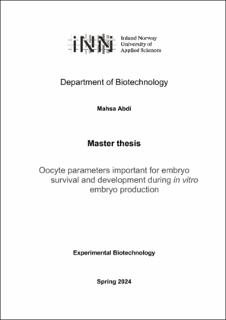| dc.description.abstract | In vitro fertilization (IVF) in cattle has been impeded by technological constraints. These limitations are related to the quality of in vitro matured (IVM) oocytes. Numerous studies have investigated factors affecting oocyte quality, and our research aimed to assess critical parameters impacting oocytes and, consequently, IVF outcomes. MitoTracker and Hoechst staining were employed to visualize the distribution pattern of mitochondria and DNA stages before and after maturation. Confocal microscopy images revealed a reorganization in mitochondria distribution from the peripheral region to the inner part of the cytoplasm during the transition of the germinal vesicle (GV) stage to the metaphase II (MII) stage. Additionally, ATP content in bovine and porcine oocytes was measured at different maturation time points. Bovine oocytes exhibited an almost stable increasing trend in ATP levels, while pig oocytes showed fluctuations, suggesting a need for further investigation. Based on ATP content results in the bovine oocytes, three time points were selected for oocyte maturation (20, 25, and 30 hours), and subsequently, IVF was performed for these three time points. Cleavage and blastocyst rates were measured two and seven days after IVF, respectively. Although no significant differences were observed in cleavage rates, the 20-hour maturation group showed the highest blastocyst yield, significantly differing from the 30-hour group (p < 0.0001). Oocytes matured for 30 hours also showed the lowest four-cell plus stage rate, with significant differences compared to the 20-hour group (p < 0.0001) as well as with the 25-hour group (p < 0.0001). This study also compared the slashing and aspiration methods for retrieving oocytes from bovine ovaries. No significant differences were observed between these two methods regarding ATP content, suggesting that the slashing method might be a possible approach for retrieving more and younger oocytes from the ovaries. In conclusion, our study highlights dynamic changes in mitochondria distribution and ATP levels during oocyte maturation. Moreover, there might be an optimal time for performing the IVF, and prolonging in vitro maturation adversely affected IVF outcomes since the 20-hour time point demonstrated the highest blastocyst yield. These findings provide valuable insights for optimizing IVF protocols in cattle. | |
